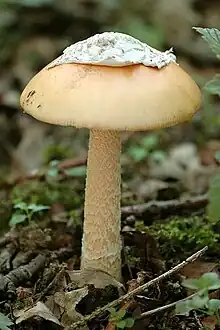| Amanita chlorinosma | |
|---|---|
 | |
| Scientific classification | |
| Domain: | Eukaryota |
| Kingdom: | Fungi |
| Division: | Basidiomycota |
| Class: | Agaricomycetes |
| Order: | Agaricales |
| Family: | Amanitaceae |
| Genus: | Amanita |
| Species: | A. chlorinosma |
| Binomial name | |
| Amanita chlorinosma | |
| Amanita chlorinosma | |
|---|---|
| Gills on hymenium | |
| Cap is convex or flat | |
| Hymenium is free | |
| Stipe has a ring and volva | |
| Spore print is white | |
| Ecology is mycorrhizal | |
| Edibility is unknown | |
Amanita chlorinosma,[1] also known as the chlorine lepidella or chlorine Amanita,[2] is a North American species of Amanita. Its life cycle is perennial. It is easily distinguished by its strong unpleasant odor.
Description
A. chlorinosma has a very large cap, up to 25 centimetres (10 inches) in diameter; it is white and covered in dense, soft, powdery scales that can be easily washed off in the rain. The gills are nearly free with cottony edges. The lower third of the stalk is frequently submerged in soil and is significantly enlarged and whitish. The annulus (ring) is thin, whitish, and frequently left on the border of caps without stalk tissue. The spore print has a strong chlorine or rotten meat smell, especially when broken open or kept in a container for a while.[3]
Toxicity
A. chlorinosma is strongly considered to be toxic due to its many poisonous characteristics, although little research has been done on this particular species. This mushroom's poisonous nature is indicated by its large size, powdered cap, enlarged stalk base, and strong chlorine or rotten meat odor. The stem is said to be the most poisonous component. It is expected that it would cause symptoms like other Amanita species if ingested: nausea, vomiting, disorientation, abdominal aches, etc. 30 minutes to several hours after consumption, symptoms start to appear.[4]
Distribution and habitat
It can be found mainly in North Carolina (Piedmont and Coastal Plain mainly)[4] but can range from Massachusetts and Illinois and south to Florida in pine and oak forest woodlands.[5]
Usually growing in landscapes, natural settings, or forests, it occurs more frequently under oak or pine trees than under pine.[4][5]
References
- ↑ Amanita chlorinosma (Peck) Lloyd (Mycol. Writ. 1(7): 7, 15. 1898). Cited from: "Amanita chlorinosma (Peck) Lloyd, Mycol. Writ. 1(7): 7, 15 (1898)". speciesfungorum.org (database). Kew, London Borough of Richmond upon Thames, Greater London, England, United Kingdom of Great Britain and Northern Ireland: Board of Trustees of the Royal Botanic Gardens, Kew. Retrieved 2017-04-24.
- ↑ "Standardized Common Names for Wild Species in Canada". National General Status Working Group. 2020.
- ↑ "Amanita chlorinosma (MushroomExpert.Com)". www.mushroomexpert.com. Retrieved 2023-04-06.
- 1 2 3 "Amanita chlorinosma (Chlorine Lepidella) | North Carolina Extension Gardener Plant Toolbox". plants.ces.ncsu.edu. Retrieved 2023-04-06.
- 1 2 "Amanita chlorinosma - Amanitaceae.org - Taxonomy and Morphology of Amanita and Limacella". www.amanitaceae.org. Retrieved 2023-04-06.
External links
 Media related to Amanita chlorinosma at Wikimedia Commons
Media related to Amanita chlorinosma at Wikimedia Commons Data related to Amanita chlorinosma at Wikispecies
Data related to Amanita chlorinosma at Wikispecies
